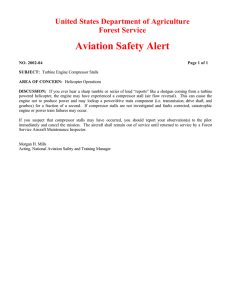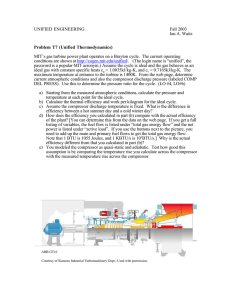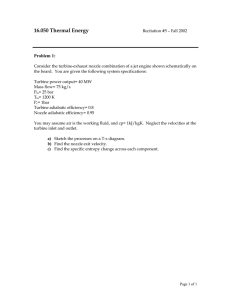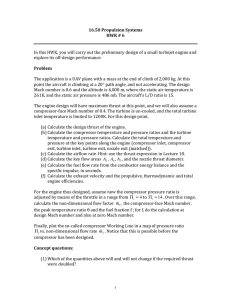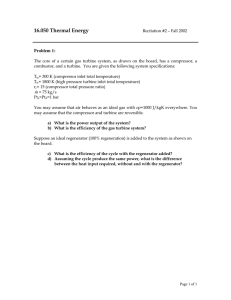Lecture 31 16.50 Subjects: Compressor -Turbine matching; Gas generators
advertisement
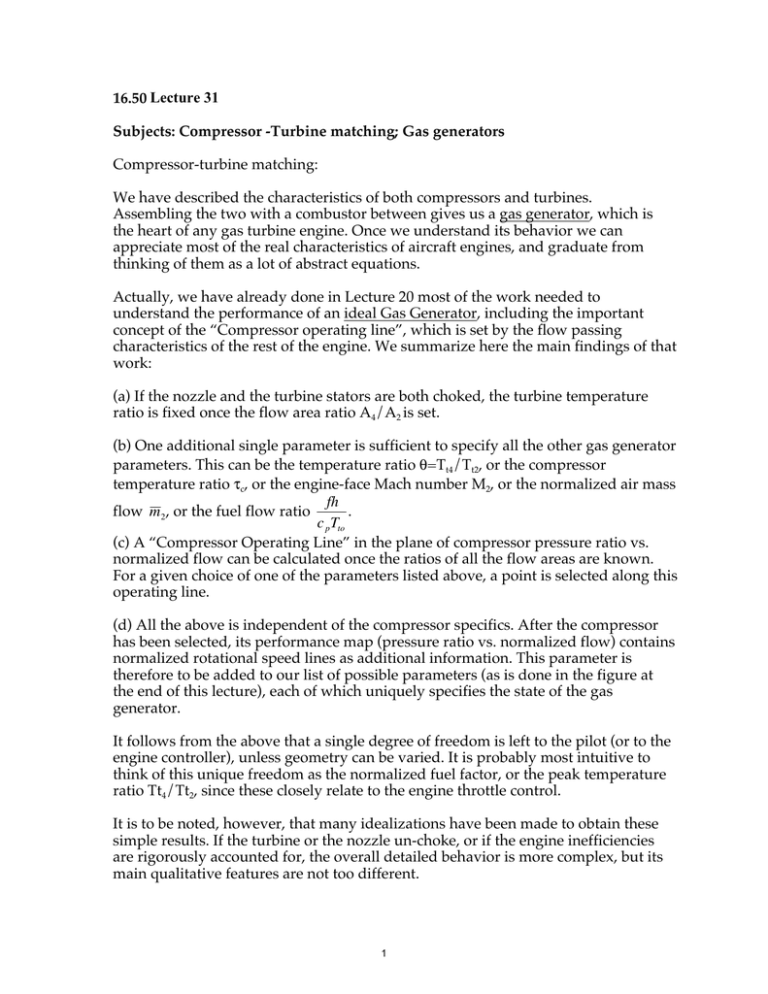
16.50 Lecture 31 Subjects: Compressor -Turbine matching; Gas generators Compressor-turbine matching: We have described the characteristics of both compressors and turbines. Assembling the two with a combustor between gives us a gas generator, which is the heart of any gas turbine engine. Once we understand its behavior we can appreciate most of the real characteristics of aircraft engines, and graduate from thinking of them as a lot of abstract equations. Actually, we have already done in Lecture 20 most of the work needed to understand the performance of an ideal Gas Generator, including the important concept of the “Compressor operating line”, which is set by the flow passing characteristics of the rest of the engine. We summarize here the main findings of that work: (a) If the nozzle and the turbine stators are both choked, the turbine temperature ratio is fixed once the flow area ratio A4/A2 is set. (b) One additional single parameter is sufficient to specify all the other gas generator parameters. This can be the temperature ratio θ=Tt4/Tt2, or the compressor temperature ratio τc, or the engine-face Mach number M2, or the normalized air mass fh flow m2 , or the fuel flow ratio . c p Tto (c) A “Compressor Operating Line” in the plane of compressor pressure ratio vs. normalized flow can be calculated once the ratios of all the flow areas are known. For a given choice of one of the parameters listed above, a point is selected along this operating line. (d) All the above is independent of the compressor specifics. After the compressor has been selected, its performance map (pressure ratio vs. normalized flow) contains normalized rotational speed lines as additional information. This parameter is therefore to be added to our list of possible parameters (as is done in the figure at the end of this lecture), each of which uniquely specifies the state of the gas generator. It follows from the above that a single degree of freedom is left to the pilot (or to the engine controller), unless geometry can be varied. It is probably most intuitive to think of this unique freedom as the normalized fuel factor, or the peak temperature ratio Tt4/Tt2, since these closely relate to the engine throttle control. It is to be noted, however, that many idealizations have been made to obtain these simple results. If the turbine or the nozzle un-choke, or if the engine inefficiencies are rigorously accounted for, the overall detailed behavior is more complex, but its main qualitative features are not too different. 1 Using these ideas, one can generate and plot a set of Gas Generator Characteristics, such as those below. With this Gas Generator, we can do lots of things a) b) c) d) e) Turbojet Turbofan Turboprop Unducted fan Helicopter Notice that the single free variable chosen for this plot is the normalized rotational speed (as a fraction of its design value). The quantity in the denominator is the nondimensional compressor-face temperature θ2= T2/T0, because the blade speed ωr is made non-dimensional with the speed of sound at station 2. 2 From Kerrebrock, Jack L. Aircraft Engines and Gas Turbines. 2nd edition. MIT Press, 1992. © Massachusetts Institute of Technology. Used with permission. 3 MIT OpenCourseWare http://ocw.mit.edu 16.50 Introduction to Propulsion Systems Spring 2012 For information about citing these materials or our Terms of Use, visit: http://ocw.mit.edu/terms.
